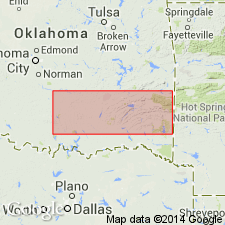
- Usage in publication:
-
- Tenmile Creek formation
- Modifications:
-
- Named
- Dominant lithology:
-
- Sandstone
- Shale
- AAPG geologic province:
-
- Ouachita folded belt
Summary:
Named as basal formation (of 3) of Stanley group (raised in rank) of Pushmataha series (new) of the Bendian period. Type section designated 3 mi east of settlement of Miller, T3S, R15E, Pushmataha Co, OK in the Ouachita tectonic belt province. Found in southeast OK in the Ouachita Mountains. Is the great valley maker of southern Ouachita Mountains. Consists generally of alternating sandstones and shales with a thickness of about 5,650 ft; lower part is 2,150 ft; upper part which includes a siliceous shale at base is 3,500 ft. Lower part consists of finely laminated olive-green shales and platy, silty shales, alternating with massive and thin-bedded, greenish colored, poorly sorted, silty, fine to coarse, rounded to subangular sandstones. Shales in upper part are predominately blue-gray to dark gray in most parts of the area; they are silty and near base of upper part are siliceous. Shales in upper part are interbedded with some green and maroon argillaceous siltstone, and some massive and thin-bedded, very fine to coarse, subangular argillaceous sandstone. Overlies the Mississippian period; underlies Moyers formation (new) of Stanley group of Pushmataha series of the Bendian period. Basal and middle siliceous shales contain spores and conodonts. Correlation chart. Columnar section of type section. Of Carboniferous age.
Source: GNU records (USGS DDS-6; Denver GNULEX).
For more information, please contact Nancy Stamm, Geologic Names Committee Secretary.
Asterisk (*) indicates published by U.S. Geological Survey authors.
"No current usage" (†) implies that a name has been abandoned or has fallen into disuse. Former usage and, if known, replacement name given in parentheses ( ).
Slash (/) indicates name conflicts with nomenclatural guidelines (CSN, 1933; ACSN, 1961, 1970; NACSN, 1983, 2005, 2021). May be explained within brackets ([ ]).

